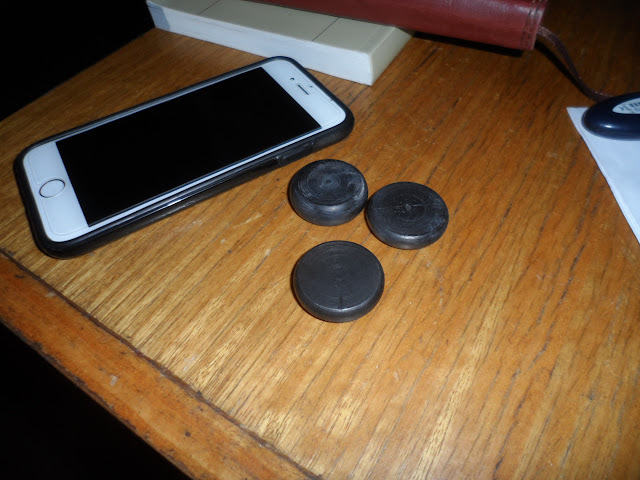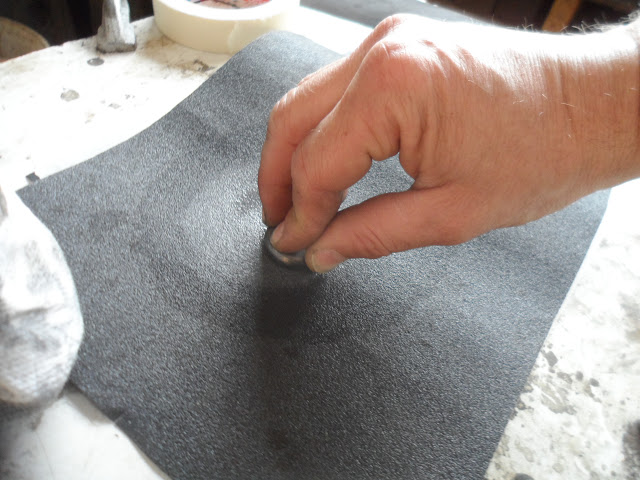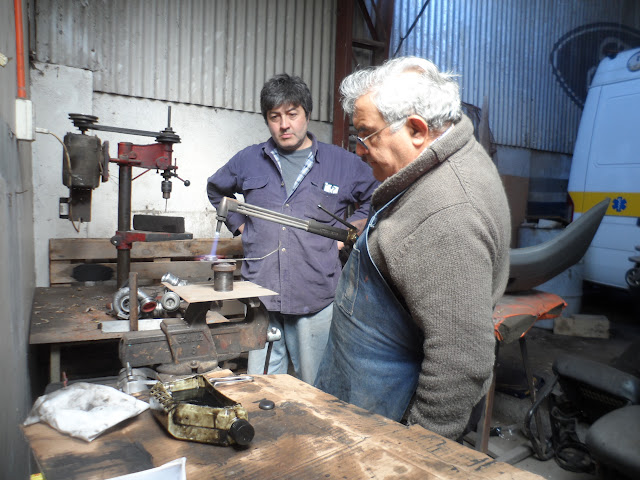I put a lot of graphite grease here and there and bolted both steering knuckle arms. So far so good, but then I applied the specified torque with the big torque wrench that was almost forgotten in a hidden corner behind the diesel tank and the right steering knuckle became more and more stiff. Damn! The sliding block was too thick, by nearly 0,5 mm. Loosened the bolts and took the steering knuckle arm out, again, to recover the piece.

I repeated the torqueing maneuver on the left side and the steering knuckle rotated freely, but when the axial play was measured it was almost two millimeters. Christ, so boring, but if not… I would have been tooooo easy.
Verardo gave me the idea of using Würth’s liquid steel to repair the worn races as a quick but temporary solution to the delayed assembly of the wheel hubs. In summary, there were no races in stock and if you needed them you had to fabricate them or order them from Germany. Bad. To extract the races you had to ruin the bearings, and there were neither in stock. Hmm… it wasn’t an easy situation... and, Christ, I felt so tired.
Finally I decided to give Würth a try. First I would polish the races with fine sandpaper, then I would clean the micropores caused by rust with metallic brushing and apply a fine layer of liquid steel to fill the pores. Once dry and hard I would sand the races and give them a polished new surface. Simple, doable, fast.
As it was still early for Saturday’s standards I got hands into it and sanded a lot with #400 sandpaper with the hard but safe rag-stripe technique. After one hour the left side race looked not so bad but, even after two hours of carefull sanding, the right side race looked not as good and you could bet that the hub ran out of oil for many kilometers. Looked like it would be a tough work for both liquid steel and oil retainers.



A phone call for lunch ended up the working session and the Merkabah stood alone the rest of the weekend.
Sunday, in the afternoon, I took the WR450 to fill up the tank. I hate to waste time filling up before starting a trip, and last time I had used the bike the fuel lever was on reserve. It was cold so I dressed up accordingly and went to the gas station, but the brisky and spirited handling of the Yamaha made my hands tickle harder and harder and, as usual, I ended up on the hills, sweaty and happy. Ah… being a hot-blooded is a very difficult condition!

Well, the thing is that the week that followed I was very busy and had time only to briefly scape from work to Verardo’s machineshop and ask him to make the sliding blocks and washers for the steering knuckles according with the measurements that I had made before. Pimentel, the turner, was charged with the job and I left very happy. Well… a little.
A few days later I went to pick the pieces and took them to the shop. Of course the measurements were not as precise as expected but at least they were close. Pimentel modified one of the sliding blocks, the thicker one, in the mechanical lathe and I would sand the other to adjust the height.

At the shop, again, I used a lot of patience and wore out the tip of my fingers sanding the sliding blocks and testing them until they were properly adjusted and the tolerance of the steering knuckles play was achieved. Good. I was setting up the place for applying the liquid steel to the already prepared races when Eduardo came and gently but firmly grabbed me by the arm and took me to the office.


In short terms, he gave me a quiet severe scold for what I was doing, and pritched about the efforts made so long, about partial repairs, about the bad heating treatment of the parts, the uses and misuses of the liquid steel, the races, the oil, the wearing forces, the sure leaking, the big mess… and all for the hurry… at this point of the story. Not in my workshop! He finally sentenced.
He was obviously right, and I was the only hurried dum, liked it or not. So, with nothing else left for considering, everything had to go out and only new pieces for the axle from then on.
I stepped out of the office, pissed off but gratefull, and disassembled the steering nuckles, again, to recover the washers and the sliding blocks. Called Maestro Chaleco who showed up after lunch with his load of experience and a brief smile that lacked of any criticism. He took the oxygen stuff and heated up the little steel pieces until they got some special color that he judged appropriate and drowned them in oil under Eduardo’s watchful eye. There was no need to add carbon or anything else according to him, and we stood to what he said.




